Banner Image
School Excursions to Help Aussie Wildlife
1. Educate yourself on koalas
The adorable Australian icon you know and love urgently needs your help. Koala numbers have been in rapid decline in recent years due to their natural habitats being wiped out. Fortunately, there are fantastic organisations in Australia that are fully committed to supporting these loveable marsupials. You can start out by cuddling a koala in Queensland – the only state where you can legally hold koalas. Magnetic Island YHA shares turf with a koala sanctuary, which educates people from all over the world on this iconic animal, and raises awareness of their threatened status.
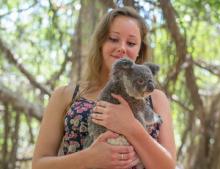
Still in Queensland, fill your koala cuddle needs at the incredible Lone Pine Koala Sanctuary in Brisbane, the world’s oldest and largest koala sanctuary. Located close by to Brisbane City YHA, learn all about the importance of conservation and protection of these adorable marsupials, and get your obligatory koala photo at the same time – it’s win-win for sure.
2. Watch the penguin parade on Phillip Island
Little Penguins, also known as Fairy Penguins, are up there with the most adorable animals in Australia. Unfortunately, these little guys are constantly threatened by pollution, the destruction of their habitat and introduced species such as foxes and feral cats. You can help out by buying a ticket to the Phillip Island Penguin Parade – watch the incredible sight of loads of adorable little penguins waddling up the beach at sunset after a day at sea catching fish.
You can also adopt your very own penguin on behalf of your class or school! Your cash will go to Phillip Island Nature Parks and support their award-winning research and conservation efforts. Help ensure the safety of the colony of penguins on Phillip Island, as well as contributing to wider research and education programs on this funny little bird, all a short walk away from comfortable and safe beds at Phillip Island YHA
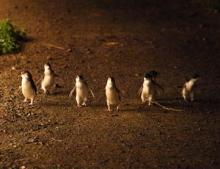
3. Go on a Sydney wildlife adventure
You can get up close and personal with Aussie wildlife right in the heart of the city! At Sydney’s Darling Harbour, you’ll find WILD LIFE Sydney Zoo. See kangaroos, a quokka, wallabies, echidnas, Tasmanian devils, koalas, crocodiles, platypuses and much more. With your support, you’ll help keep the Wild Life Conservation Fund going, which champions conservation through educational and research projects. Right next door is SEA LIFE Sydney Aquarium, which showcases penguins, sharks, dugongs, tropical fish, rays, seahorses and loads more.
Your visit to the aquarium helps support the SEA LIFE Trust, who are committed to protecting the oceans and everything that lives in them. With WILD LIFE Sydney Zoo and the aquarium right next to each other, it's a no-brainer to visit them both and support their important work, while having a fantastic day out. Thankfully, there’s plenty of great group accommodation a short walk away, so you’ll have plenty of time to soak in all the sights with your school group without needing to rush back!
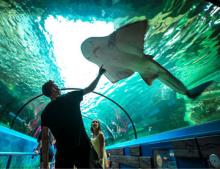
4. Feed kangaroos and emus at Cleland Wildlife Park
Cleland Wildlife Park is one of the few places that openly encourages touching and interacting with wildlife up close. There are very few animal enclosures at Cleland - most are living in their natural habitat, and you can get as close to them as you like! Look out for kangaroos, wallabies, wombats, dingoes, Tasmanian devils, native birds, echidnas and snakes (those are in an enclosure, of course!) Buy a bag of feed and you’re free to feed the free-roaming animals and even touch them (just make sure to wash your hands after).
If you fancy paying a little more, you can enjoy unique encounters with koalas, reptiles, butterflies and wombats, and learn all about them from experienced keepers. Experiencing all this is a steal - concession tickets cost $20 while adult tickets are $25.50. The cash you spend goes towards protecting the wildlife of the area as well as protecting the unique flora and fauna of Cleland Conservation Park as a whole. Make sure you stop here during your visit to Adelaide for your chance to really interact with both of Australia's national animals.
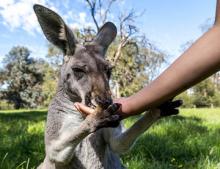
5. Adopt a quokka!
Quokkas are too adorable for words! The happiest animal in the world is famous for its big smile and not shying away from humans. The reason for this is because in their native home of Rottnest Island, the quokka has no natural predators. Unfortunately, there is only about 4000 of these little guys left in the world, and they need your help to ensure that people can go on to meet them and get their quokka selfies for years to come. You can help by adopting a quokka, and you can even help during your visit to Rottnest by taking care not to touch or feed quokkas in case you make them sick.
Quokkas aren’t the only things on the island that need protecting. Rottnest Island as a whole is a Class A Reserve, meaning it needs the highest level of protection to protect all the unique species that call this area home. Experience the incredible island, just a short trip from Perth or Fremantle on the Western Coast.
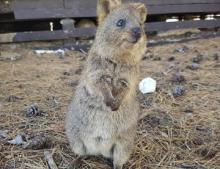
6. Support the Great Barrier Reef
The Great Barrier Reef is one of the Seven Natural Wonders of the World for a reason – it is truly stunning to behold. Sadly, the effects of climate change as well as pollution have placed the world’s largest living thing under serious threat. Fortunately, there are ways to support the Reef’s conservation efforts. Contrary to popular belief, visiting the Reef helps support it – as all visitors are required to pay a mandatory Environment Management Charge, AKA a tax, contributing to the day-to-day management of the Reef.
You can also visit Reef Teach before your visit to learn all about the Reef from qualified marine biologists. They will entertain, educate and captivate you with knowledge about the importance of the Reef and how to make the most of your visit. Head north to Cairns for easy access to the complex and stunning reef, and soak up some sunshine on your school trip!
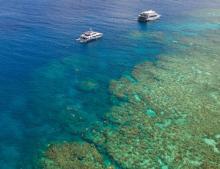
7. Visit some orphaned kangaroos in the outback
Kangaroos aren’t exactly an endangered species in Australia, but every single one of our beloved national animals deserves to be healthy and happy! This is where Alice Springs’ iconic Kangaroo Sanctuary comes in – it started out as a baby kangaroo rescue centre, and now operates as a 188 acre wildlife sanctuary for rescued kangaroos of all ages. Their mission is to educate and encourage people to rescue and care for kangaroos, as well as other wildlife.
Because kangaroos like to sleep during the day, the best way to visit the kangaroos is to take a guided sunset tour, where you can learn all about these iconic animals and cuddle a baby! There is still a long way to go to develop the hospital – so visit the kangaroos in the outback like a true Aussie and see why they're worth helping.
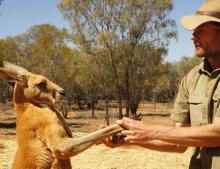
8. Save the Tasmanian devil from extinction
Here’s an interesting concept – a zoo that is so unlike a regular zoo, it’s called an “unzoo.” The reason for its name is because at the Tasmanian Devil Unzoo, you will have face-to-face encounters with a huge range of animals in unique, innovative habitats designed to duplicate its natural environment. You can meet quolls, possums, wallabies, kangaroos, birds, pademelons and of course, the elusive Tasmanian Devil.
Saving the Tasmanian Devil has become a worldwide project and a matter of life or death. Unlike other endangered species where the threat is usually external, Tasmanian Devils are endangered due to a fatal and contagious form of cancer known as Devil Facial Tumour Disease. Tasmanian Devil Unzoo are helping stop the spread of this cancer to Tasmanian Devils in the wild, and you can help them out simply by visiting the Unzoo for $36. The Tasmanian Devil desperately needs your help – get to beautiful Tasmania and help save the last surviving Devils, just an hour out of Hobart.
9. Check out Zoos Victoria
Zoos Victoria makes up Melbourne Zoo, Healesville Sanctuary and Werribee Open Range Zoo. Melbourne Zoo is right in the heart of the city, offering you the chance to see a huge range of both Australian and exotic animals, from the little penguin to the Sumatran tiger. Healesville Sanctuary is known for its outstanding breeding program, and allows you to get up close and personal with Aussie wildlife in a stunning bushland setting.
Finally, Werribee Open Range Zoo is African Safari themed – visit lions, hippos, giraffes, gorillas and more! While each venue is unique, each one is part of Zoos Victoria’s Fighting Extinction initiative, a huge project that involves research, education and both national and international conservation programs. They are even training dogs to help protect Australia’s most threatened species! Simply paying a visit to one or more of Zoos Victoria's fantastic zoos will help support these important projects – just hop a tram from Melbourne Metro YHA for easy access!
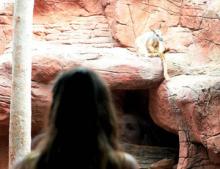
10. Channel your inner Crocodile Hunter
There are fantastic zoos all around Australia which all do significant conservation work, but Australia Zoo, home of the Irwins, has to be one of the best. You can see a huge range of animals, from adorable possums to enormous pythons. Australia Zoo also offers the best animal encounters - for a little extra cash, you can walk with tigers, get a photo with a cheetah, get face to face with a rhino and so much more! Simply visiting the zoo helps support Australia’s wildlife, but there’s also plenty of other ways you can go the extra mile.
Make a donation to the Wildlife Warriors and you’ll help support their many conservation projects, including the Australia Zoo Wildlife Hospital that has helped give over 82,000 Australian animals another chance at life. For just $50, you can house an orphaned animal for a week before it is placed with a wildlife carer for rehabilitation. There’s definitely worse things to spend your money on than a fantastic day at Australia Zoo, helping keep Australian animals surviving and thriving in the process.
Learn more about group accommodation and school excursions with YHA Australia, including wildlife tours and bookings by heading to www.yha.com.au/group-bookings
